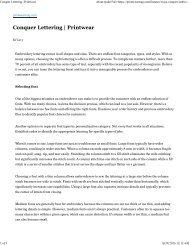Embroidery Basics Articles
You also want an ePaper? Increase the reach of your titles
YUMPU automatically turns print PDFs into web optimized ePapers that Google loves.
Common Problems with Digital <strong>Embroidery</strong> Stitch Files – Help Center<br />
https://help.zazzle.com/hc/en-us/articles/221986647-Common-Problems-...<br />
2 of 4 10/28/2016 12:06 AM<br />
shrink it down for a left chest, then the entire 100,000 stitches would<br />
compress to that size. Their stitch lengths would also shorten. In the end,<br />
the garment would sustain too many stitches and disintegrate (tear or rip,<br />
especially at the edges of the design). The opposite effect happens when a<br />
small image is expanded to accommodate a larger area. In this case, there<br />
would not be enough stitches or density to cover the area, so the design<br />
would be gapped.<br />
3. Pull Compensation Errors - Digitizing is not the same as graphic design.<br />
An image may look fine on screen and not sew properly. Take the case of a<br />
simple fill with an outline (a square or circle). The fill would sew first, and<br />
then the outline would sew around it. However, as the fill sews in the<br />
garment, the sewn threads will tighten, and this will cause the garment to<br />
draw up, or condense. In embroidery, this is called "pull". Pull occurs most<br />
in the direction of sew, so in the case of a circle sewn with a horizontal stitch,<br />
the distance from left to right would be less than the distance from top to<br />
bottom when a final product is completed. To achieve a perfect circle,<br />
therefore, the designer would need to design an ellipse. To achieve a<br />
square, the designer would need to create a rectangle with the longest<br />
distance in the direction of the sew. After sewing the fill, the outline would<br />
then be sewn, but since the garment has changed during the fill, the outline<br />
would need to be designed in such a way to account for this change. Most<br />
professional digitizers will create files that appear to be misaligned on<br />
screen, but in fact these files sew correctly when run on commercial<br />
embroidery machines. This misalignment and distortion to achieve a perfect<br />
end result is called "pull compensation". When a final product is sewn and<br />
gaps and misalignments occur, then the design failed to account for the<br />
fabric distortion.<br />
4. Wrong Stitch Type - Not all stitches can be used to achieve the results we<br />
would want in our logo. There are basically three types: complex fills,<br />
column (satin) stitches, and manual stitches. Of these, the most common<br />
error by digitizers is using a column stitch on logo items that are too small.<br />
Column stitches are created using a loop stitch from one side of the column




